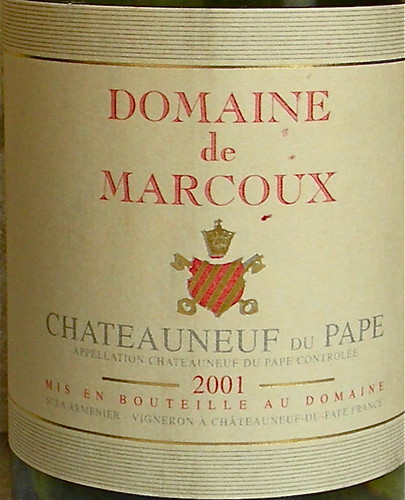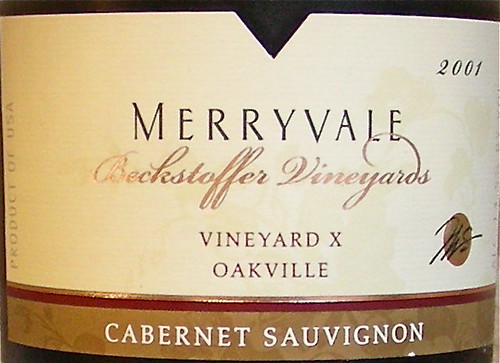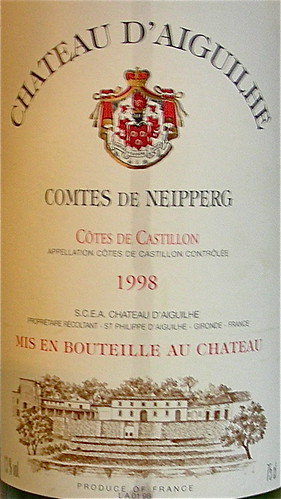“Can you train your nose?” inquires wine writer Natasha Hughes in the November edition of Decanter Magazine. Moreover, can people that professionally rely on their sense of smell accurately identify aromas outside their field of expertise? Three experts, a sommelier, a tea buyer, and a perfumier, were put to the test with tea, wine, and perfume samples.
The sommelier, Mathieu Gaignon, doesn't think he was born with extrordinary skills. “I believe the sense of smell is one you can train,” he says. “The trick is to find a way of associating an image with a particular smell.” For him, detecting the aromas of the perfume samples was easier than for the tea samples, which were more subtle, although he ended up with the same score for the tea as for the wine.
The tea buyer, Edward Eisler, “learned about tea just by being interested in it.” “When you're focused and you drink a lot of tea, you can pick up the subtleties,” he says. Although he acknowledged not being into perfume, he got the top score for the perfume and tea samples.
The perfumier, Linda Pilkington, was never formally trained, although she admits that perfume bottles was a childhood obsession. For her, the way we interpret aromas is personal. “Sometimes a smell reminds you of something personal to you, and it does not smell like that to someone else, ” she says. She thought that the aromas of the tea samples were the hardest to capture.
My conclusion is that our sense of smell should benefit from regular exercise. So next time you pour yourself a glass of wine, close your eyes, sniff, and enjoy!
Technorati tags: wine food & drink
The smell of wine, oh how much more delicate, cheerful, gratifying, celestial and delicious it is than that of oil. François Rabelais (1495-1553)
Friday, October 24, 2008
Friday, October 17, 2008
I am glad we had the Popes in Avignon
Because the popes were great wine lovers, they did much to promote local viticulture and winemaking while the Papacy was located in Avignon. Châteauneuf-du-Pape, which means New Castle of the Pope is a wine district a few miles north of Avignon that has become the most renowned appellation in the southern Rhône Valley. It is also a small town with a 14th-century castle that was build by Pope John XXII as a summer residence.

Châteauneuf-du-Pape
Local winegrowers have traditionally planted different grape varieties to enhance their wines and improve quality. So for this reason, the Châteauneuf-du-Pape appellation allows thirteen grape varieties. Red wines are usually blends of Grenache, Syrah, and Mourvèdre and to a lesser extend, Cinsault, Counoise, Muscardin, Terret Noir, and Vaccarèse. White varieties include Grenache Blanc, Clairette, Roussanne, Bourboulenc, Picpoul Blanc, and Picardan (Grenache and Picpoul may be used both in the red and white versions so the actual number of allowed varieties is in fact fifteen).
 The Domaine de Marcoux is one of my favorite Châteauneuf-du-Pape producers. It is also one of the oldest properties with family vineyards dating back to 1344. It is run today by the two sisters, Catherine Armenier and Sophie Estevenin. The property that includes 10 acres of 95 year-old-vines, is farmed biodynamically.
The Domaine de Marcoux is one of my favorite Châteauneuf-du-Pape producers. It is also one of the oldest properties with family vineyards dating back to 1344. It is run today by the two sisters, Catherine Armenier and Sophie Estevenin. The property that includes 10 acres of 95 year-old-vines, is farmed biodynamically.
I recenty opened a bottle of their 2001 vintage. The wine exhibited fragrant aromas of sweet fruit compote. On the palate, it was concentrated and full with more ripe black fruit flavors and spices, leaving a lasting impression of harmony and balance. What a pleasure! Next time, try a Châteauneuf-du-Pape with a lamb stew with figs and olives.
Technorati tags: wine food & drink

Châteauneuf-du-Pape
Local winegrowers have traditionally planted different grape varieties to enhance their wines and improve quality. So for this reason, the Châteauneuf-du-Pape appellation allows thirteen grape varieties. Red wines are usually blends of Grenache, Syrah, and Mourvèdre and to a lesser extend, Cinsault, Counoise, Muscardin, Terret Noir, and Vaccarèse. White varieties include Grenache Blanc, Clairette, Roussanne, Bourboulenc, Picpoul Blanc, and Picardan (Grenache and Picpoul may be used both in the red and white versions so the actual number of allowed varieties is in fact fifteen).
 The Domaine de Marcoux is one of my favorite Châteauneuf-du-Pape producers. It is also one of the oldest properties with family vineyards dating back to 1344. It is run today by the two sisters, Catherine Armenier and Sophie Estevenin. The property that includes 10 acres of 95 year-old-vines, is farmed biodynamically.
The Domaine de Marcoux is one of my favorite Châteauneuf-du-Pape producers. It is also one of the oldest properties with family vineyards dating back to 1344. It is run today by the two sisters, Catherine Armenier and Sophie Estevenin. The property that includes 10 acres of 95 year-old-vines, is farmed biodynamically. I recenty opened a bottle of their 2001 vintage. The wine exhibited fragrant aromas of sweet fruit compote. On the palate, it was concentrated and full with more ripe black fruit flavors and spices, leaving a lasting impression of harmony and balance. What a pleasure! Next time, try a Châteauneuf-du-Pape with a lamb stew with figs and olives.
Technorati tags: wine food & drink
Wednesday, October 08, 2008
A rich wine from Oakville, in the heart of Napa Valley
Located north of the town of Yountville in the Oakville AVA, Beckstoffer Vineyard X is a 45 acres vineyard planted to multiple clones of Cabernet Sauvignon and Merlot in deep and well-drained soils. It was purchased in 1996 by Andy Beckstoffer, one of the most important grape growers in California. With vineyards in Napa Valley, Mendocino and Lake County, the family owned Beckstoffer Vineyards delivers over 10,000 tons of fruit annually to more than 50 wineries.

Beckstoffer Vineyard X
 With fruits sourced from Beckstoffer Vineyard X Merryvale Vineyards produces a single vineyard 100% Cabernet Sauvignon and the 2001 Merryvale Cabernet Sauvignon Beckstoffer Vineyard X was their second release. The wine went through native yeast fermentation, was aged 18 months in 100% French oak and was bottled unfiltered.
With fruits sourced from Beckstoffer Vineyard X Merryvale Vineyards produces a single vineyard 100% Cabernet Sauvignon and the 2001 Merryvale Cabernet Sauvignon Beckstoffer Vineyard X was their second release. The wine went through native yeast fermentation, was aged 18 months in 100% French oak and was bottled unfiltered.
When we tasted the wine the other night, it was opaque and dark with a lot of black fruit on the nose. On the palate, it was dense with lot of weight. However, I found the wine much too big to accompany our usual dinner fare. Actually, I would rather recommend the more balanced Reserve Cabernet Sauvignon from the same winery.
Technorati tags: wine food & drink

Beckstoffer Vineyard X
 With fruits sourced from Beckstoffer Vineyard X Merryvale Vineyards produces a single vineyard 100% Cabernet Sauvignon and the 2001 Merryvale Cabernet Sauvignon Beckstoffer Vineyard X was their second release. The wine went through native yeast fermentation, was aged 18 months in 100% French oak and was bottled unfiltered.
With fruits sourced from Beckstoffer Vineyard X Merryvale Vineyards produces a single vineyard 100% Cabernet Sauvignon and the 2001 Merryvale Cabernet Sauvignon Beckstoffer Vineyard X was their second release. The wine went through native yeast fermentation, was aged 18 months in 100% French oak and was bottled unfiltered. When we tasted the wine the other night, it was opaque and dark with a lot of black fruit on the nose. On the palate, it was dense with lot of weight. However, I found the wine much too big to accompany our usual dinner fare. Actually, I would rather recommend the more balanced Reserve Cabernet Sauvignon from the same winery.
Technorati tags: wine food & drink
Wednesday, October 01, 2008
Bordeaux wine: it has everything and nothing more
 I was not sure what to expect the other night when I opened a bottle of 1998 Château d'Aiguilhe. It is a Côtes de Castillon, an appellation next to Saint-Emilion that had the reputation to produce rather rustic wines, although of good value. Located on hills overlooking the Right Bank of the Dordogne River, Château d'Aiguilhe is one of the oldest estate in the region. Its sun-facing vineyards have excellent natural drainage with thin clay soils over a limestone base. In 1998, the estate was acquired by Stephan von Neipperg of Château Canon La Gaffelière. Since then, a new modern cellar has been built and new vines have been planted.
I was not sure what to expect the other night when I opened a bottle of 1998 Château d'Aiguilhe. It is a Côtes de Castillon, an appellation next to Saint-Emilion that had the reputation to produce rather rustic wines, although of good value. Located on hills overlooking the Right Bank of the Dordogne River, Château d'Aiguilhe is one of the oldest estate in the region. Its sun-facing vineyards have excellent natural drainage with thin clay soils over a limestone base. In 1998, the estate was acquired by Stephan von Neipperg of Château Canon La Gaffelière. Since then, a new modern cellar has been built and new vines have been planted.Although the 1998 vintage didn't benefit from these costly investments, the wine was absolutely delicious. A blend of 80 percent Merlot and 20 percent Cabernet Franc, it showed a deep garnet color with a hint of orange at the rim. The nose was peppery with aromas of sweet berries. On the palate, it was medium-bodied with notes of earth, blackberry, and cocoa, and a rather lengthy finish.
That reminded me of that quote from Jean-Bernard Delmas, chief winemaker at Château Haut-Brion, that I read recently. “Le Bordeaux: il a tout et rien de plus.” (The Bordeaux: it has everything and nothing more).
Technorati tags: wine food & drink
Subscribe to:
Comments (Atom)